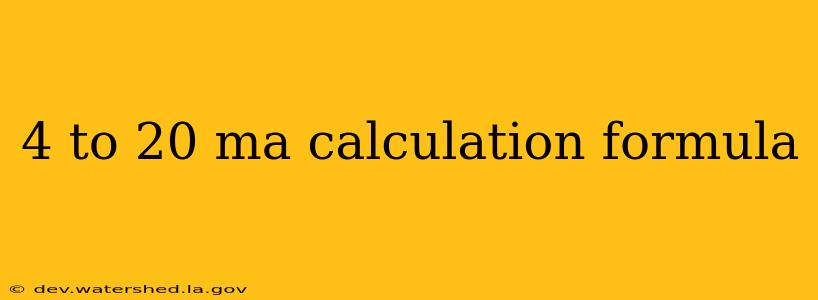Understanding 4-20 mA Calculations: A Comprehensive Guide
The 4-20 mA signal is a widely used industrial standard for transmitting analog process variable data. This article delves into the calculations involved in understanding and utilizing this crucial signal, answering common questions and providing practical examples. We'll explore how to convert the milliampere signal into engineering units, troubleshoot signal issues, and explain the importance of this standard.
What is the 4-20 mA signal and why is it used?
The 4-20 mA signal represents a process variable, such as temperature, pressure, or flow rate. A current of 4 mA typically represents the lower limit of the measured variable, while 20 mA represents the upper limit. This system offers several advantages over other analog transmission methods:
- Noise Immunity: Current signals are less susceptible to noise interference compared to voltage signals, making them more reliable in industrial environments.
- Simple Calibration: The linear relationship between current and measured variable simplifies calibration and data interpretation.
- Power Transmission: The 4-20 mA signal can also supply power to remote sensors, eliminating the need for separate power wiring.
How do I calculate the process variable from the 4-20 mA signal?
The core calculation involves a simple linear relationship:
Process Variable = [(mA reading - 4 mA) / (20 mA - 4 mA)] * (Span)
Where:
- mA reading: The measured current in milliamperes.
- Span: The difference between the upper and lower limits of the process variable.
Example:
Let's say we have a temperature sensor with a range of 0°C to 100°C (Span = 100°C), and we measure a current of 12 mA.
Temperature = [(12 mA - 4 mA) / (20 mA - 4 mA)] * 100°C = (8 mA / 16 mA) * 100°C = 50°C
What if my 4-20 mA signal is not within the 4-20 mA range?
If your signal falls outside the 4-20 mA range (e.g., below 4 mA or above 20 mA), this usually indicates a problem. Possible causes include:
- Sensor Failure: The sensor might be malfunctioning or damaged.
- Wiring Issues: A broken wire, short circuit, or poor connection can lead to inaccurate readings.
- Power Supply Problems: Insufficient power to the sensor or transmitter can cause a low signal.
- Signal Interference: Noise interference may corrupt the signal.
How do I convert the engineering units back to a 4-20 mA signal?
This is the inverse of the above calculation:
mA reading = [(Process Variable / Span) * (20 mA - 4 mA)] + 4 mA
Example:
If we want to represent a temperature of 75°C with the same 0-100°C sensor:
mA reading = [(75°C / 100°C) * (20 mA - 4 mA)] + 4 mA = (0.75 * 16 mA) + 4 mA = 16 mA
How do I troubleshoot a 4-20 mA signal?
Troubleshooting involves a systematic approach:
- Check the Sensor: Verify the sensor is functioning correctly and calibrated properly.
- Inspect Wiring: Look for breaks, shorts, or loose connections in the wiring.
- Verify Power Supply: Ensure the sensor and transmitter have sufficient power.
- Use a Multimeter: A multimeter can measure the current to check if it's within the 4-20 mA range.
- Loop Check: Check the entire 4-20 mA loop for any abnormalities.
What are some common applications of 4-20 mA technology?
The 4-20 mA signal is ubiquitous across numerous industrial processes:
- Process Control: Monitoring and controlling parameters like temperature, pressure, flow, and level in manufacturing plants, refineries, and power generation facilities.
- Building Automation: Controlling HVAC systems, lighting, and security systems.
- Instrumentation: Used in various sensors and instrumentation devices.
By understanding the basic principles and calculations involved in 4-20 mA signal transmission, engineers and technicians can effectively monitor, control, and troubleshoot industrial processes. Remember to always prioritize safety and follow established procedures when working with electrical systems.
